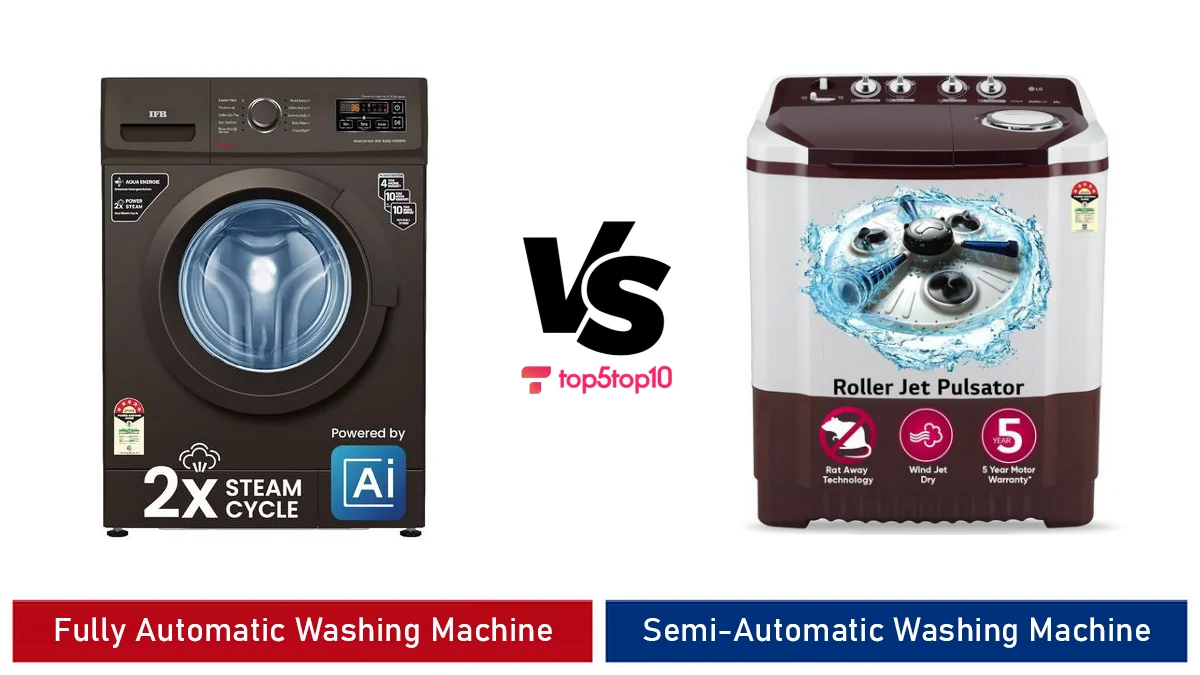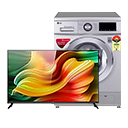
Fully Automatic vs Semi-Automatic Washing Machine – Washing machines have revolutionized the way we do laundry, offering convenience and efficiency to modern households.
However, when it comes to choosing a washing machine, consumers often find themselves at a crossroads: should they opt for a fully automatic washing machine or a semi-automatic one?
This decision depends on various factors, including your laundry needs, budget, and available space.
In this comprehensive guide, we will explore the differences between fully automatic and semi-automatic washing machines.
We’ll delve into their definitions, advantages, limitations, and the critical factors you should consider before making a decision.
By the end of this article, you’ll have the knowledge needed to choose the perfect washing machine for your home.
Contents
1. Understanding Fully Automatic Washing Machines
1.1 Definition and Operation
Fully automatic washing machines are designed to provide a hassle-free laundry experience.
They come equipped with an integrated system that handles the washing, rinsing, and spinning functions automatically.
This means that once you load your laundry and select the desired settings, the machine takes care of the entire laundry process from start to finish.
Table 1: Features of Fully Automatic Washing Machines
| Feature | Description |
|---|---|
| Operation | Fully automatic, handles washing, rinsing, and spinning. |
| Convenience | Minimal manual intervention required. |
| Efficiency | Typically more water and energy-efficient. |
| Washing Time | Offers shorter washing cycles. |
| Suitable for | Busy households with frequent laundry needs. |
1.2 Advantages of Fully Automatic Washing Machines
Fully automatic washing machines offer several advantages:
- Convenience: Fully automatic machines require minimal manual intervention. Once you load the laundry and select the settings, you can carry on with other tasks while the machine does the work.
- Efficiency: These machines are often more water and energy-efficient compared to their semi-automatic counterparts, making them environmentally friendly and cost-effective in the long run.
- Shorter Washing Time: Fully automatic machines typically offer shorter washing cycles, allowing you to complete your laundry quickly.
- Suitable for Busy Households: They are ideal for households with frequent laundry needs, where convenience and efficiency are paramount.
1.3 Limitations of Fully Automatic Washing Machines
However, fully automatic washing machines also come with certain limitations:
Table 2: Limitations of Fully Automatic Washing Machines
| Limitation | Description |
|---|---|
| Higher Upfront Cost | Fully automatic machines tend to be more expensive initially. |
| Longer Wash Cycles | While washing cycles are efficient, they may be longer compared to semi-automatic machines. |
| Continuous Water Supply | Fully automatic machines require a continuous water supply during operation. |
- Higher Upfront Cost: Fully automatic washing machines often have a higher initial purchase price compared to semi-automatic machines.
- Longer Wash Cycles: While their washing cycles are efficient, they may be longer compared to semi-automatic machines, which can be a consideration if time is a significant factor.
- Continuous Water Supply: Fully automatic machines require a continuous water supply during operation, which may not be suitable in areas with water scarcity or inconsistent water sources.
2. Understanding Semi-Automatic Washing Machines
2.1 Definition and Operation
Semi-automatic washing machines are designed with two separate tubs—one for washing and one for spinning.
Unlike fully automatic machines, they require some manual intervention during the laundry process.
After the washing cycle is complete, you must transfer the laundry to the spinning tub for the drying process.
Table 3: Features of Semi-Automatic Washing Machines
| Feature | Description |
|---|---|
| Operation | Semi-automatic, with separate washing and spinning tubs. |
| Convenience | Requires manual intervention between washing and spinning. |
| Efficiency | May consume more water and energy. |
| Washing Time | Washing cycles may be longer. |
| Suitable for | Smaller households with less frequent laundry needs. |
2.2 Advantages of Semi-Automatic Washing Machines
Semi-automatic washing machines have their own set of advantages:
- Cost-Effective: These machines are typically more budget-friendly, making them an excellent choice for those on a tighter budget.
- Flexibility: You have manual control over the washing and spinning processes, allowing you to tailor each cycle to your specific needs.
- Suitable for Water-Scarce Areas: Semi-automatic machines may be a better choice in areas with water scarcity since they do not require a continuous water supply during operation.
- Space-Saving: They are often more compact and space-efficient, making them suitable for homes with limited laundry area space.
2.3 Limitations of Semi-Automatic Washing Machines
However, semi-automatic washing machines also come with certain limitations:
Table 4: Limitations of Semi-Automatic Washing Machines
| Limitation | Description |
|---|---|
| Manual Intervention | Requires manual transfer of laundry between washing and spinning tubs. |
| Relatively Inefficient | May consume more water and energy compared to fully automatic machines. |
| Longer Washing Time | Washing cycles may be longer due to manual intervention. |
| Suitable for Smaller Households | Ideal for smaller families with less laundry to do. |
- Manual Intervention: Semi-automatic machines require manual intervention between washing and spinning cycles, which can be time-consuming.
- Relatively Inefficient: They may consume more water and energy compared to fully automatic machines, which can impact operating costs.
- Longer Washing Time: Washing cycles may be longer due to the need for manual transfer of laundry between tubs.
- Suitable for Smaller Households: Semi-automatic machines are best suited for smaller families with less laundry to do.
3. Factors to Consider When Choosing Between the Two
The choice between a fully automatic and a semi-automatic washing machine should align with your specific household needs, budget, and preferences.
Let’s explore the critical factors that should influence your decision:
3.1 Household Size and Laundry Volume
1. Household Size: Consider the size of your family. Larger families typically generate more laundry, and a fully automatic washing machine with its efficiency and convenience may be better suited to handle the load.
2. Laundry Volume: Evaluate how frequently you do laundry. If you find yourself doing multiple loads of laundry each week, a fully automatic machine can save you time and effort.
Table 5: Household Size and Laundry Volume
| Consideration | Fully Automatic Machine | Semi-Automatic Machine |
|---|---|---|
| Household Size | Ideal for larger families with significant laundry needs. | Suitable for smaller households with less frequent laundry. |
| Laundry Volume | Efficient for frequent laundry loads. | May require more time and effort for frequent laundry. |
3.2 Water Availability and Conservation
1. Water Availability: Consider the availability of a continuous water supply in your area.
Fully automatic machines require uninterrupted water access, while semi-automatic machines are more adaptable in areas with water scarcity.
2. Water Conservation: Assess your commitment to water conservation. Fully automatic machines tend to be more water-efficient, making them a greener choice if water conservation is a priority.
Table 6: Water Availability and Conservation
| Consideration | Fully Automatic Machine | Semi-Automatic Machine |
|---|---|---|
| Water Availability | Requires a continuous water supply. | Suitable for areas with water scarcity or inconsistent supply. |
| Water Conservation | Typically more water-efficient. | May consume more water. |
3.3 Budget and Cost Considerations
1. Initial Cost: Compare the initial purchase price of both types of machines.
Semi-automatic machines are often more budget-friendly, which can be appealing if you have budget constraints.
2. Long-Term Costs: Consider the long-term operating costs, including electricity and water bills.
Fully automatic machines tend to be more energy and water-efficient, potentially saving you money over time.
Table 7: Budget and Cost Considerations
| Consideration | Fully Automatic Machine | Semi-Automatic Machine |
|---|---|---|
| Initial Cost | Higher initial purchase price. | More budget-friendly. |
| Long-Term Costs | Typically more energy and water-efficient, potentially saving money over time. | May have higher long-term operating costs. |
3.4 Convenience and Time
1. Convenience: Evaluate how important convenience is to you. Fully automatic machines require minimal manual intervention, allowing you to set it and forget it.
On the other hand, semi-automatic machines involve more manual effort.
2. Time Constraints: Consider your daily schedule and whether you can spare the time for manual interventions, such as transferring laundry between tubs in a semi-automatic machine.
Table 8: Convenience and Time
| Consideration | Fully Automatic Machine | Semi-Automatic Machine |
|---|---|---|
| Convenience | Offers convenience with minimal manual intervention. | Requires more manual effort. |
| Time Constraints | Ideal for those with busy schedules. | May require more time for laundry tasks. |
3.5 Space Constraints
1. Available Space: Assess the available space in your laundry area.
Fully automatic machines are typically larger and may require more space, whereas semi-automatic machines are often more compact.
2. Dimensions: Check the dimensions of both types of machines to ensure they fit comfortably in your designated laundry area.
Table 9: Space Constraints
| Consideration | Fully Automatic Machine | Semi-Automatic Machine |
|---|---|---|
| Available Space | Requires more space. | Suitable for homes with limited laundry area space. |
| Dimensions | Check the dimensions to ensure a proper fit. | Compact design may be more space-efficient. |
Conclusion
Choosing between a fully automatic and a semi-automatic washing machine is a significant decision that hinges on various factors, each tailored to your specific household needs and preferences.
Let’s summarize the key takeaways to help you make an informed choice:
Fully Automatic Washing Machines:
- Ideal for larger households with significant laundry needs.
- Efficient for frequent laundry loads, saving time and effort.
- Require a continuous water supply and may be more water-efficient.
- Typically have a higher initial cost but may save money in the long term.
- Offer convenience with minimal manual intervention, making them suitable for busy individuals.
- May require more space in your laundry area.
Semi-Automatic Washing Machines:
- Suitable for smaller households with less frequent laundry.
- Require manual intervention between washing and spinning cycles.
- Can be a better choice in areas with water scarcity or inconsistent water supply.
- Often more budget-friendly with a lower initial cost.
- Require more manual effort but are adaptable for those with flexible schedules.
- Compact design may be a space-efficient option.
Ultimately, the choice between the two types of washing machines depends on your priorities.
If convenience and efficiency are paramount, a fully automatic machine might be the right fit.
On the other hand, if budget-friendliness and adaptability are crucial, a semi-automatic machine could be your preferred choice.
To make an informed decision, consider your household size, laundry volume, water availability, budget, time constraints, and available space.
By weighing these factors, you can select the washing machine that best suits your unique needs and lifestyle.
In conclusion, both fully automatic and semi-automatic washing machines have their own set of advantages and limitations.
The key is to align your choice with what matters most to you and your household.
With the information provided in this guide, you’re well-equipped to make the right decision and ensure that your laundry needs are met efficiently and effectively.
Remember that the perfect washing machine is the one that simplifies your laundry routine and provides clean, fresh clothes for you and your family.
Whether you opt for fully automatic or semi-automatic, both choices offer a step towards a cleaner, more convenient laundry experience.
Fully Automatic vs Semi-Automatic Washing Machine FAQs
What's the main difference between a fully automatic and a semi-automatic washing machine?
The primary difference between a fully automatic and a semi-automatic washing machine lies in the level of automation and user involvement.
Fully automatic washing machines handle the entire wash cycle, including washing, rinsing, and spinning, with minimal manual intervention.
In contrast, semi-automatic machines require manual transfers of laundry from one tub to another during the wash cycle.
Which is more convenient, fully automatic or semi-automatic washing machines?
Fully automatic washing machines are generally considered more convenient due to their automation.
They require minimal user involvement, and you don't need to transfer clothes between tubs during the wash cycle.
Semi-automatic machines require more manual effort but may be more budget-friendly.
Which type of washing machine is more water-efficient?
Fully automatic washing machines are often more water-efficient because they come with features like load sensors and various wash programs designed to optimize water usage based on the laundry load.
In contrast, semi-automatic machines may use a fixed amount of water for each cycle, potentially leading to higher water consumption.
Are fully automatic washing machines more expensive than semi-automatic ones?
Fully automatic washing machines tend to be more expensive than semi-automatic machines due to their advanced features, automation, and convenience.
The price difference varies depending on the brand, model, and capacity. Semi-automatic machines are generally more budget-friendly.
Can I use a fully automatic washing machine for small loads, or should I choose a semi-automatic for such purposes?
You can use a fully automatic washing machine for small loads, but it's essential to select the appropriate wash cycle and water level settings to optimize water and energy efficiency.
Fully automatic machines often come with settings for smaller loads, ensuring efficient washing without excessive water usage.
However, if you frequently wash small loads, you may also consider a smaller capacity fully automatic machine or a compact washing machine designed for such purposes.
|
Related Tags
Fully automatic vs semi automatic washing machine which is better, Fully automatic vs semi automatic washing machine top load, Fully automatic vs semi automatic washing machine samsung, Fully automatic vs semi automatic washing machine pros and cons, Fully automatic vs semi automatic washing machine price, Fully automatic vs semi automatic washing machine front load, disadvantages of fully automatic washing machine, semi automatic vs fully automatic washing machine
Last update on 2024-05-12 at 11:48 / Affiliate links / Images from Amazon Product Advertising API













